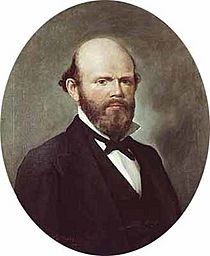William Rainey Marshall facts for kids
Quick facts for kids
William Rainey Marshall
|
|
|---|---|
 |
|
| 5th Governor of Minnesota | |
| In office January 8, 1866 – January 9, 1870 |
|
| Lieutenant | Thomas H. Armstrong |
| Preceded by | Stephen Miller |
| Succeeded by | Horace Austin |
| Personal details | |
| Born | October 17, 1825 Columbia, Missouri, U.S. |
| Died | January 8, 1896 (aged 70) Pasadena, California, U.S. |
| Political party | Republican |
| Spouse | Abby Langford |
| Profession | banker, farmer |
William Rainey Marshall (October 17, 1825 – January 8, 1896) was an American leader. He was the fifth Governor of Minnesota. He served from January 8, 1866, to January 9, 1870. He was a member of the Republican political party. He was also an officer in the 7th Minnesota Volunteer Infantry Regiment during the American Civil War (1861–1865).
Contents
Early Life and Moving West
William Rainey Marshall was born in Columbia, Missouri. He first lived in Illinois and Wisconsin. There, he worked in lead mines and helped survey land.
In 1848, he was chosen to be part of the Wisconsin State Assembly. He was a Democrat at that time. However, another person, Joseph Bowron, successfully argued that Marshall's home was actually on the Minnesota side of the new state line. So, Marshall lost his seat.
In 1849, he moved across the St. Croix River to settle in St. Paul. This city soon became home to his new hardware store. He served one term in the first Minnesota territorial legislature. His reputation grew when he became an important leader in starting the state's Republican Party.
Serving in the Military
Before becoming governor, William Marshall had many jobs. He was a banker, a dairy farmer, a stock-raiser, and a newspaper owner. He volunteered to fight in both the Civil War and the Dakota War of 1862.
He joined the 8th Minnesota army group as a private soldier. Soon after, on August 28, 1862, he became a lieutenant colonel in the 7th Minnesota. He fought in many battles during the Dakota War. On November 6, 1863, he was promoted to colonel of his army group.
Marshall and his army group were later moved to Andrew Jackson Smith's command in Missouri. They helped chase after Sterling Price's forces. Smith's command then joined George H. Thomas's army outside Nashville. During the Battle of Nashville, Colonel Sylvester G. Hill died. Colonel Marshall then took charge of Hill's army unit and led it for the rest of the battle. He continued to lead this unit when they moved to Mobile, Alabama. There, they took part in the Battle of Fort Blakeley. On March 13, 1865, Colonel Marshall was given the honorary rank of brigadier general of volunteers.
Governor of Minnesota
Marshall won the elections for governor in 1865 and 1867. As governor, he strongly pushed for a law to give all Black people the right to vote. The legislature voted against it twice. But finally, they adopted the law. This made Marshall declare that the "free young state of Minnesota" was "now altogether free."
During William Marshall's time as governor, Minnesota grew a lot after the Civil War. Its population doubled to 350,000 people. The amount of railroad tracks quadrupled, meaning it became four times longer. Businesses also did very well.
Later Life and Legacy
After leaving office, Marshall stayed active in public and private life. He worked as a lawyer, a banker, and a railroad and land commissioner. He was a partner in a law firm in St. Paul. However, some of his later business ideas did not work out, and his health got worse.
He moved to California in 1894. He died there two years later. He was known as one of the few leaders who followed Swedenborgianism, a type of Christian faith.
In Minnesota, Marshall County and the city of Marshall were both named after him.

